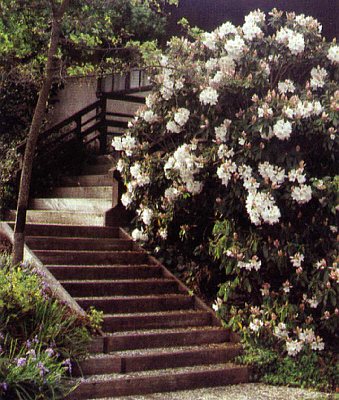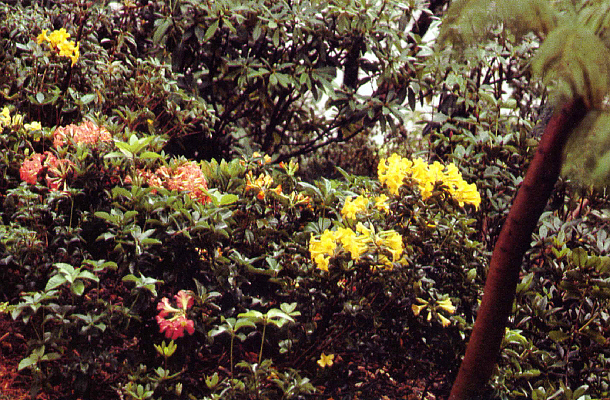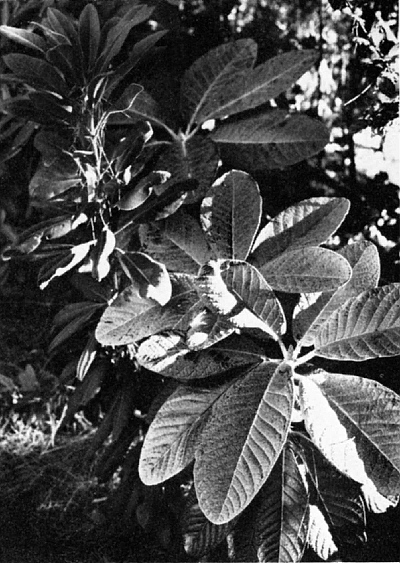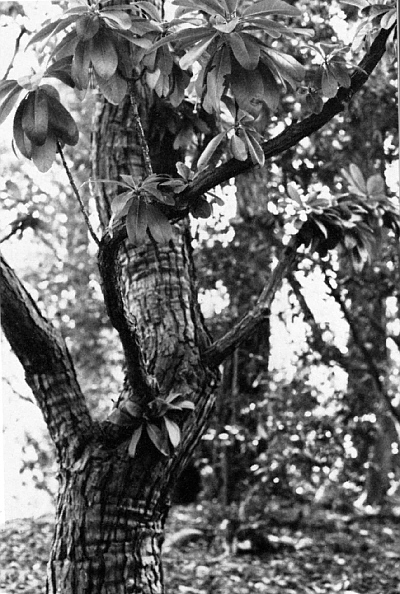QBARS - v35n1 1981 Annual Convention
1981 Annual Convention "Rhododendrons of the Pacific Basin"
Fred W. Coe, Ross, CA
Fred Cummings, Orinda, CA
The site of the annual meeting this spring is the Sheraton Palace Hotel in the center of San Francisco. This dowager of San Francisco hotels was originally built in 1875, but was rebuilt after the 1906 earthquake and fire at a cost of $8 million. It is a famous hotel and has been hostel to many famous persons, among them King Kalakaua, Queen Juliana of the Netherlands, Winston Churchill, Oscar Wilde, Enrico Caruso, and both Teddy and Franklin Roosevelt. It is in the heart of San Francisco's financial-commercial center on Market Street.
If you think "old" means "dowdy" we think you'll be pleasantly surprised. The charm of the old has been preserved by the new owners. The famous Italian marble-columned Garden Court, with its elegant glass dome, is as sumptuous as when horse-drawn carriages drove through it to deposit their finely dressed occupants to dine on the Palace's golden table service. The public rooms we will meet in are decorated in the empire style, often with gilded molding, beautifully restored to the early 1900's elegance. The Palace was our first choice among all the hotels in the city, and we think you will enjoy the combination of the rejuvenation with the modern hotel operation. The hotel is indeed a palace, fit for a display of beautiful flowers and a gathering of happy rhododendron fanciers.
This is an exciting time for rhododendron enthusiasts, with China open again and collectors from around the world bringing us new plants and seeds. We hope to capture some of this excitement for you. Our theme is "Rhododendrons of the Pacific Basin" and we have excellent speakers. There is Dr. Peter Valder, from the University of Sydney, Australia. He has done extensive collecting of tropical species of rhododendrons as well as visiting a number of regions in China. He also has researched the problems inherent in hybridizing vireya species with the other lepidote species. Paul Kores of the Bishop Museum in Honolulu has spent four years in New Guinea collecting and propagating over 57 different species of rhododendrons and is completing a manuscript on the species that occur above 3000 meters. His special interest is pollination biology. Dr. John Creech will draw on his extensive knowledge of Japan and his six collecting trips to show us the richness of the azalea and rhododendron species found there and will outline the methods of collecting. Ron Coker from New Zealand is an ardent grower and collector who lives near the I lam collection of rhododendrons and is sure to have something interesting to say about plants grown in his country. Dr. Robert Raabe, plant pathologist from The University of California in Berkeley, in addition to being on the frontier in the fight against ornamental pathogens, is an ardent gardener and expert on composting and mulching. Bruce Bartholomew from the University of California Botanical Gardens in Berkeley has collected in the Himalayas and more lately, China.
We hope to give you a better idea of the wide variety of spectacularly flowered vireyas, both in nature and in cultivation. Many of us grow them in the open garden if close to the Bay, but others grow them in the home or office and many of you could do the same. As you know, these plants include an amazing color range, with bright yellows and oranges, and some have powerful fragrance, sweet, clove scented, or entirely different.
We will show you some beautiful slides of our early blooming evergreen rhododendrons which start in January and bloom in steady succession until your arrival at the end of April. There will be a display of flowers blooming on April 30th in our area, including old favorites, species and some recent hybrids.
For live outdoor viewing we will visit California's most famous rhododendron garden, Golden Gate Park; the University of California Botanical Garden in Berkeley; and three private gardens in the East Bay. Many of you have seen Golden Gate Park. Most of you have not seen its fairly recent outdoor plantings of vireyas in Strybing Arboretum. The plants of R. arboreum , R. grande , and R. protistum at U.C. Botanical Garden will have passed their flowering season, but you will see many rhododendrons in flower and many of the large-leaved plants of the grande series that are beautiful in their old and new growth.
|
|
None of the private gardens you will see is on the scale of the Dexter Estate, but we hope they will all give you some good ideas and pleasant memories to carry home. In the Oakland gardens of Dr. and Mrs. John Paul Evans you will see the largest and most beautiful outdoor planting of vireyas in California, 15 feet tall R. nuttalliis crowned with huge, fragrant creamy-white trusses, and many Cinnabarinum-Maddenii Series hybrids. Interspersed are various maples, Davidia, and other companion plants, as well as many lovely herbaceous plants in a suburban garden. In the 53 year old Berkeley garden of Mr. and Mrs. Phillip McCombs you will see rarities such as the spectacularly flowered 'Victorianum', many Maddenii Series species and hybrids, as well as large, beautiful examples of some old standbys such as 'Mrs. Furnival' and the Loderis, 'King George', and 'Venus', plus large plants of some old, less common hybrids such as 'Mount Everest'. In the garden of Fred and Clare Cummings you will see a large mixture of 10 to 12 year old seedling rhododendrons, mostly from ARS seed. This includes many of the large leaved species and some of their hybrids as yet un-bloomed. A feature of this garden is a koi carp pond, the product of a year's work on the part of the owners.

|
|
'Mrs. A. T. de la Mare', a 20 year old plant
in the Cummings garden. Photo by Fred Cummings |

|
|
Garden view of vireyas in Jack Evans garden.
Photo by Jack Evans |
Each of the three private gardens has had one or more rhododendron hazards to surmount. The Evans garden was built on a solid rock outcropping. The McCombs garden is mostly under eucalyptus trees whose invasive roots are generally thought to be impossible companions for rhododendrons. The Cummings garden is in Orinda on the east side of the Oakland-Berkeley hills, in a hot and cold (by California standards) climate, often felt more suited to oleanders than to rhododendrons. We hope you will take home from your visit to these gardens some ideas for your own.
We look at this meeting as an opportunity for both you and us to see some old and make new friends, enjoy our flowers, our program and our city. We intend to put on a good party. What we need to make it complete is you!

|
|
R. nuttallii
Photo by Dr. Jack Evans |
The cover picture is rhododendron nuttallii in the garden of Dr. & Mrs. John P. Evans, one of the gardens to be toured at the annual meeting, on May 1, 1981. These plants are for me the highlights of the Evans garden. Nuttallii is often seen in ungainly and sparsely flowered young plants. These mature specimens, mostly over 12 feet tall, have made magnificent, lush groves of foliage crowned in spring with large, powerfully fragrant trusses of fleshy flowers, white with a yellow throat. Other bonuses are the red, peeling bark on the decorative bare trunks, and the red-purplish flush to the new foliage. Jack Evans calls them his "cabbages", and the luxuriant, turgid heads of foliage atop red stems make them look as easy to grow as cabbages. Unfortunately, while they seem very much at home in the Evans' garden, they are not always seen in this area as apparently happy as they are for the Evans'.


